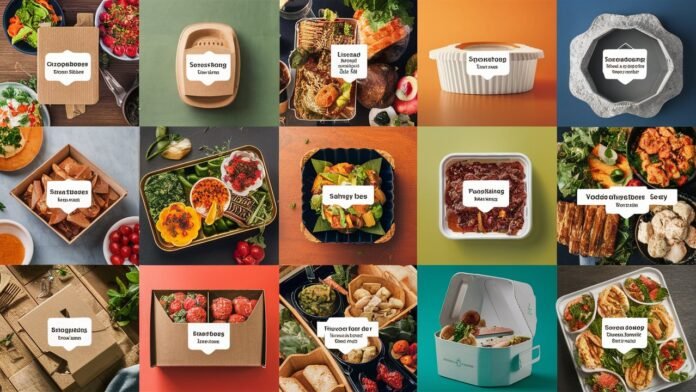Choosing the right food packaging containers is crucial for preserving the quality, freshness, and safety of your products. With a wide range of options available in the market, it can be overwhelming to make the best decision for your business. However, by considering key factors such as material, size, design, and sustainability, you can select packaging that not only protects your food but also enhances your brand image and appeals to your target audience. In this article, we will explore 10 essential things to keep in mind when choosing food packaging container, helping you make an informed decision that aligns with your business goals and values.
Food Safety and Compliance
The primary consideration when selecting food packaging containers is ensuring the safety and compliance of the materials used. Choose containers that are made from food-grade materials, free from harmful chemicals, and approved by relevant regulatory bodies. This will not only protect your customers but also demonstrate your commitment to quality and safety.
Barrier Properties
The barrier properties of the packaging material are crucial for maintaining the freshness and quality of your food products. Look for containers that offer excellent barrier protection against oxygen, moisture, and light, which can cause food spoilage and reduce shelf life. Consider materials like glass, metal, or high-barrier plastics that provide optimal barrier properties to keep your food fresh for longer.
Durability and Strength
The durability and strength of the packaging containers are essential for protecting your products during transportation, storage, and handling. Choose containers that are sturdy enough to withstand potential impacts, stacking, and compression without compromising the integrity of the food. This will help reduce the risk of damage and minimize food waste due to packaging failure.
Ease of Use and Convenience
Consider the ease of use and convenience of the packaging containers for both your customers and your business. Look for containers with user-friendly features such as easy-open lids, resealable closures, or microwavable designs that enhance the customer experience. For your business, choose containers that are easy to fill, seal, and label, streamlining your packaging process and improving efficiency.
Branding and Aesthetics
The packaging containers you choose can significantly impact your brand image and appeal to your target audience. Select containers that align with your brand’s identity, colors, and messaging, and consider incorporating design elements that make your products stand out on the shelf. A well-designed package can enhance the perceived value of your products and create a lasting impression on your customers.
Sustainability and Environmental Impact
In today’s eco-conscious market, sustainability is a crucial factor to consider when choosing food packaging containers. Look for containers made from renewable, recyclable, or compostable materials that minimize the environmental impact. This not only demonstrates your commitment to sustainability but also appeals to environmentally aware consumers who are increasingly seeking out eco-friendly products.
Cost-Effectiveness
While quality and sustainability are essential, cost-effectiveness is also a significant consideration when selecting food packaging containers. Evaluate the total cost of the packaging, including material costs, production expenses, and potential savings from reduced waste or increased efficiency. Choose containers that provide the best value for your money without compromising on quality or sustainability.
Portion Control and Serving Size
Depending on your product and target market, portion control and serving size may be important factors to consider when choosing food packaging supplies wholesale. Select containers that offer the right portion size for your customers, whether it’s individual servings, family-sized portions, or bulk quantities. This can help reduce food waste and ensure that your customers receive the appropriate amount of product for their needs.
Tamper Evidence and Security
In certain situations, incorporating tamper-evident features into your food packaging containers is crucial to ensure the safety and quality of your products. Tamper-evident packaging is designed to provide visible evidence if the container has been opened or tampered with, deterring unauthorized access and protecting the contents from contamination.
When selecting food packaging containers, look for options that feature tamper-evident seals, shrink bands, or other security measures. These features create a tight seal that cannot be broken without leaving clear signs of tampering, such as a broken seal or torn band. This visual confirmation assures customers that the product they are purchasing has not been tampered with and is safe for consumption.
By incorporating tamper-evident packaging, you can give your customers peace of mind knowing that their food has been protected throughout the supply chain. This not only enhances the safety and quality of your products but also builds trust in your brand and demonstrates your commitment to customer well-being. Investing in tamper-evident food packaging is a proactive measure that can help prevent potential issues and maintain the integrity of your products.
Flexibility and Customization
Finally, consider the flexibility and customization options available for your food packaging containers. Look for suppliers or manufacturers that offer a range of sizes, shapes, and designs to accommodate your specific product requirements and allow for future growth or changes. Additionally, explore opportunities for customization, such as custom printing, labeling, or embossing, to further enhance your brand identity and differentiate your products in the market. Ultimately, the flexibility and customization options available from your compostable food packaging supplier can play a significant role in the success and growth of your food business.
Choosing the right food packaging containers is a multifaceted decision that requires careful consideration of various factors, from food safety and compliance to sustainability and cost-effectiveness. By prioritizing the key elements that are most important for your business and your customers, you can select packaging that not only protects your products but also enhances your brand image and contributes to your overall success in the competitive food industry. Remember to stay informed about the latest trends, regulations, and best practices in food packaging to ensure that your choices align with the evolving needs of the market and your business goals.
